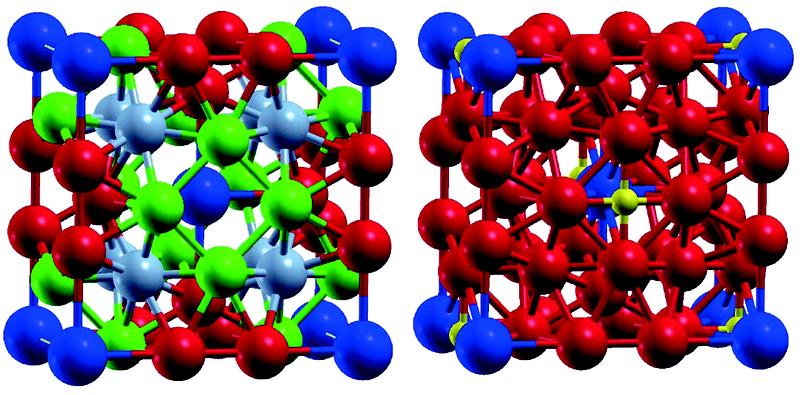

Left: the crystal structure of thorium manganese (ThMn12) with atoms of neodymium (blue balls) has better magnetic properties than super magnets, though is unstable; right: more stable structure.
The image © Fraunhofer Institute for Mechanics of Materials IWM
The starting point for IWM researchers Wolfgang Körner, Georg Krugel, and Christian Elsässer was a neodymium-iron-nitrogen compound based on a type of thorium-manganese crystalline structure.
“The neodymium-iron-nitrogen compound we used has better magnetic properties than current super magnets made of neodymium, iron, and boron,” explains Georg Krugel, though the material is apparently not yet stable, having only been produced in thin layers up to now.
The goal of the group Materials Modeling’s project was to identify a new permanent magnet that exhibits the same or better magnetic properties, such as strength and directional stability, as well as the required material stability. Differing atoms in the crystal structure were systematically varied across a range of values using the new HTS process.
The researchers initially replaced the neodymium atoms with other rare earth elements such as cerium, which is considerably more economical. They then substituted iron partially by transition metals like cobalt, nickel, and titanium as well as by other elements like silicon. The HTS produced 1,280 variations this way that the researchers analyzed with respect to their properties.
Concentration on material stability, strength, and directional stability of the magnetization
“We concentrated on three properties quite important for applications during our analyses of the variations in materials,” explains Krugel. The researchers first examined the stability of the material, which could be estimated from the energy of formation. The second important aspect is the maximum attainable energy product, which allows the strength of the magnet to be estimated. The energy of anisotropy, which is a measure of the directional stability of the magnetization, is also very important for the intended application. The researchers were able to identify twelve especially promising candidates from among the 1280 variations this way.
Validation with the help of existing experimental magnetic materials
The pivotal question of course is whether the calculated properties of the variations in materials created in the computer correspond to reality. The researchers therefore additionally validated them against existing permanent magnets. The results confirmed the predictive power of the model for the magnetic properties of the HTS candidates.
General trends
Besides identifying promising approaches in materials for new permanent magnets, the researchers were able to ascertain important general trends through their work. “It was evident that cerium and neodymium are better suited on the whole than samarium,” according to Krugel. Cerium in particular exhibited extremely high anistropy. Among the transition metals, the researchers were able to increase the predictability of titanium’s suitability especially.
“While transition metals reduce the strength of the magnet, they increase its directional stability considerably as well,” Krugel summarizes. Valid predictions can also now be made for atoms additionally incorporated into the crystal lattice. Nitrogen and carbon are better suited than boron utlilized in current supermagnets.
New kinds of magnets might be able to be made experimentally based on the predictions of the new HTS approach. Computer-aided predictions offer an avenue for industry to identify and improve materials required to have specific properties.
Publication:
Körner, W. et al. Theoretical screening of intermetallic ThMn12-type phases for new hard-magnetic compounds with low rare earth content. Sci. Rep. 6, 24686; doi: 10.1038/srep24686 (2016).
http://www.nature.com/articles/srep24686 – link to publication
http://www.en.iwm.fraunhofer.de/business-units/materials-design/materials-modeli… – link to group Materials Modeling












